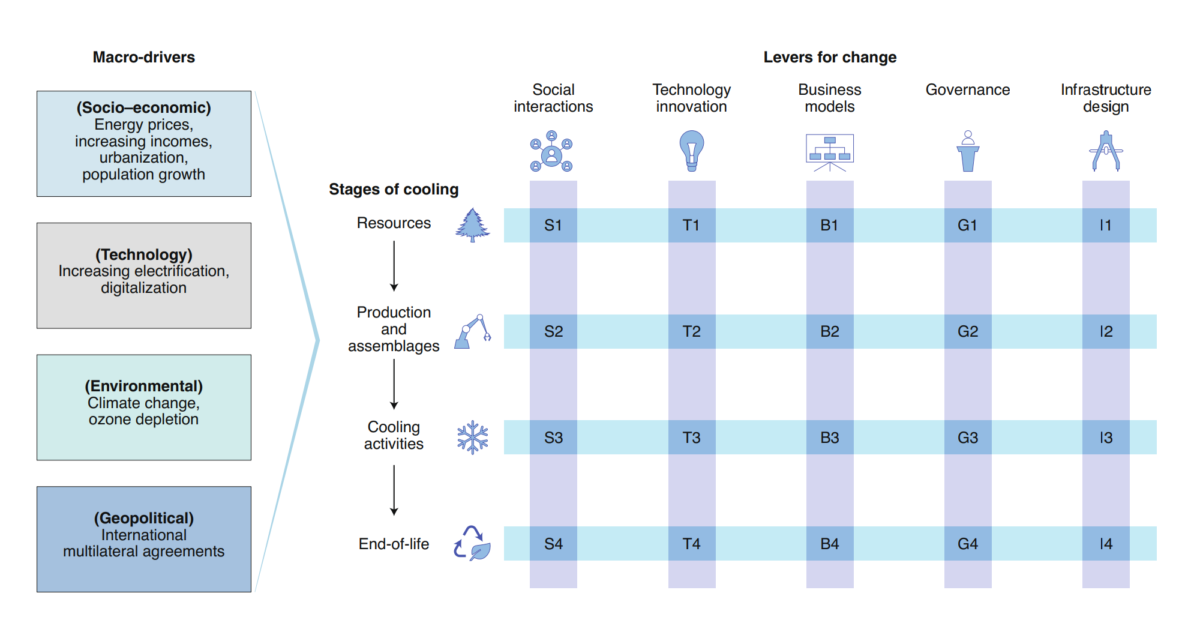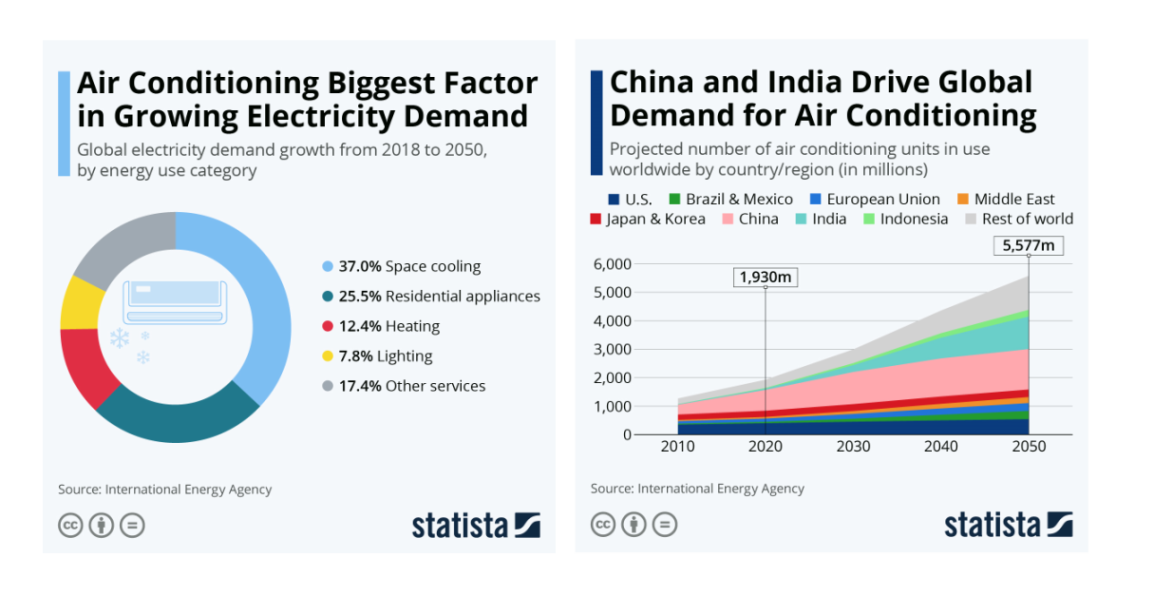Latest Cooling News: Oxford vacancy, new opportunities, future visions and more!
Come join us!
Are you interested in researching sustainable cooling? Come be a part of our team and shape future cooling demand patterns.
We’re looking for someone to join our exciting multidisciplinary programme on the Future of Cooling and share in the process of producing research to influence policy-making. Our programme investigates cooling as a dynamic system, and examines its interlinkages across the Sustainable Development Goals in the developing and developed world.
Our aim is to steer the system towards sustainable cooling for all, and to establish cooling as a global priority for the successful implementation of the SDGs. This Research Associate position will focus on how production networks for cooling technologies can expand access while improving the environmental sustainability of the products and their production.
This is a full time role for 2 years. You can find out more here.
The deadline is noon, 3 August 2020
The aim is to promote renewable energy in sub-Saharan Africa to boost long-term job creation and reduce poverty through economic growth and the empowerment of women.
It is hoped that the resources provided by the IKEA Foundation, €5m, together with the €5.9m from UK Aid will lever more funding to reach €20 million. PREO expects to create 3,500 rural jobs, empower 1,000 women and benefit more than 11,000 rural households.
One PREO partner is Enviu. One of its projects is SokoFresh, which focuses on developing the potential of the Kenyan horticulture market, by offering cold as a service.
The project will provide off-grid mobile cold storage facilities, on a pay-as-you store basis. This will help small-scale horticulturalists who cannot afford the upfront capital needed to install their own equipment. Given that approx. 50% of all horticulture produce in Kenya fails to make it to market as a result of an informal and unreliable supply chain, providing cold as a service will reduce post-harvest losses, reduce logistical costs and help increase sales.
 Great News! Romania and Liberia have boosted the number of ratifications of the Kigali Amendment to the Montreal Protocol to 100!
Great News! Romania and Liberia have boosted the number of ratifications of the Kigali Amendment to the Montreal Protocol to 100!
Signatories to the Kigali Amendment to the Montreal Protocol commit to cut the production and consumption of HFCs by more than 80% over the next 30 years.
Focus on the UK
The UK Government has released a new guide which outlines UK efforts on sustainable cooling.
The UK is a champion member of the Cool Coalition, and co-lead of Mission Innovation’s ‘Affordable heating and cooling of buildings ‘ challenge (IC7) with the European Commission and United Arab Emirates.
As a member, the UK understands that action is required to reduce the need for mechanical cooling, shift to cooling with lower emissions including by using renewables, improve cooling efficiency, and protect those most vulnerable to a lack of cooling. A key focus is to support ambitious action on cooling, as it underpins each priority theme for COP26.

Funding for sustainable cooling
The DFID funded KTN Clean Energy Catalyst and Innovate UK have launched funding support for highly innovative, market-focused, clean energy solutions in any technology or sector. Up to 70% of costs can be covered. Registration closes on 16 Sep 2020, 11:00.
Proposals must be collaborative, with international organisations partnering with a UK lead. UK organisations can apply individually. As well as addressing all elements of the energy trilemma – cost; emissions; security of supply and energy access – projects must encourage the development of products and services that help countries in sub-Saharan Africa, South Asia, South East Asia or multiple regions access secure, low cost and low carbon energy. They must be targeted at people, public services and local enterprises who are unable to afford or access existing solutions, or who lack the time or expertise to successfully use those solutions.
DFID is particularly interested in supporting projects in the areas of:
- sustainable cooling
- modern cooking
- next generation solar
- efficient and productive appliances
- technologies and business models which help leave no-one behind
Click here for more details.
Too hot to handle!
A study in Nature Communications has set out the increasing likelihood of temperatures above 40°C in the UK.
Following the UK record of 38.7 °C, set in Cambridge in July 2019, the study shows how human influence is increasing the likelihood of exceeding 30, 35 and 40°C locally. The researchers used an ensemble of 16 climate models to perform their analysis, and found that temperatures above 35°C are predicted to be increasingly common in the southeast of the UK, and it is forecast that more northerly areas will exceed 30°C at least once per decade by 2100. At the moment, summer temperatures of above 40 °C in the UK have a return frequency of 100-300 years but this is expected to significantly reduce to 3.5 years by 2100, if greenhouse gas emissions are not mitigated.
Temperatures above 35°C are becoming increasingly common in the southeast of the UK, and it is forecast that more northerly areas will exceed 30 °C at least once per decade by 2100. At the moment, summer temperatures of above 40 °C in the UK have a return frequency of 100-300 years but this is expected to significantly reduce to 3.5 years by 2100, if greenhouse gas emissions are not mitigated.
The research shows that such heat could become a regular occurrence by the end of the century unless carbon emissions are cut to zero. Global heating has already made UK heatwaves 30 times more likely and extreme temperatures led to 3,400 early deaths from 2016-19.
Another study paired iconic cities around the world to illustrate how their climates will shift due to climate change. Using cities as analogues helps citizens, land managers and city planners to visualize the climate futures of their respective cities, and help climate (and therefore cooling) orientated decision-making.
The researchers found that even under an optimistic climate scenario, over 77% of the world’s cities are likely to experience a shift towards the climate conditions of another major city by 2050, while 22% will shift to climate conditions that are not currently present for any major cities on the planet. They predict that by 2050 London’s climate will resemble Barcelona’s climate today, Stockholm will resemble Budapest, Madrid to Marrakech, Moscow to Sofia, Seattle to San Francisco, and Tokyo will resemble Changsha.
The National Geographic has used IPCC data to show how cities across the world will change under climate change. It has analysed 2,500 populated areas across the globe in order to understand what the world could feel like in 50 years.
An example from the tool is shown here for Sangli, India which is considered to currently have a current arid, hot steppe climate. It is highly likely that conditions in Sagnli will change so much that it will become a tropical savannah climate. By the 1970s, Sangli will feel more like Tokar in Sudan does today, in terms of temperature, precipitation and seasonality.
The implications of increased temperatures are profound and will affect all aspects of our lives, from overheated buildings to a reduced ability to work and socialise. Hot temperatures particularly affect vulnerable people but not exclusively. Prolonged exposure to high heat levels can cause a range of issues from dehydration, cardiovascular issues, kidney stones to heat exhaustion. Heat can adversely affect infrastructure, melting roads, destabilising rail tracks, softening cables, and lead to overheating of equipment for telecoms, the internet and other digital services.
Hot weather conditions present individuals and local decision-makers with new challenges on how to stay safe from both hot weather and COVID-19.
The Global Heat Health Information Network has created a series of Heat and COVID-19 Information Briefings. These highlight issues and options to take into consideration when managing the risks of extreme heat during the pandemic and are targeted at heath care workers, planners, local authorities, managers and the general public etc to help manage heat risk. Countries should expect and prepare for hot weather and heatwaves, in addition to managing COVID19.
Regulators! Stop illegal cooling
…in the UK
Karl Richardson, director of air conditioning distributor Logicool undertook a survey of installers. This revealed that many had been asked to install equipment bought off the internet, in contradiction to the regulations.
Despite requests to the UK Environment Agency, the body tasked with policing and enforcing the regulations, little has been done, hugely undermining the extra cost and effort that reputable companies expend to comply with F-gas rules and achieve certification.
…and across Europe!
The need to enforce regulations is also called for by the EFCTC, the European FluoroCarbons Technical Committee which report that illegal refrigerant imports could have been as much as one third of EU market in 2018. It’s a thriving black market, driven by the rise in HFC costs caused by the F-gas phase down, and removal of certain gases off the market.
The emissions escaping from these systems is could be as high as 34 million tonnes CO2eq; the equivalent of 1.2 million people in Europe taking a transatlantic flight every day for a month, or adding 25 million new cars to European roads.
![]()
![]()
![]()
![]()
![]()
![]()
![]()
![]()
![]()
![]()
![]()
![]()
The European Commission recently published a combined Evaluation Roadmap and Inception Impact Assessment proposing changes to the F-gas regulations to align them more to the Montreal Protocol’s Kigali Amendment; raising ambition to support the European Green Deal; greater enforcement of the regulations to prevent illegal imports and misuse of the quota system.
The EFCTC chair, Dr Nick Campbell said, “We believe that one of the critical topics that the review must concentrate on is the enforcement of the regulation. There is evidence of large quantities of illegally imported HFCs entering the European Union and this must be addressed during the review by the addition of measures aimed at improved monitoring and reporting, in particular a strengthening of the regulation with respect to transit procedures.”

Impact of a Warming Climate on UK Food Retail Refrigeration Systems
 An in-depth analysis by Imperial College London, in partnership with Sainsbury’s, has explored the 2018 heat wave on refrigeration systems. Refrigeration accounts for half of supermarket-store energy consumption.That unusually hot summer is expected to become the norm for by 2050, so the data from 2018 can be used to assess the ability of refrigeration technology, and the industry, to cope with a warming climate. The researchers used 2018 data from 30 Sainsbury’s shops in the UK, and compared them to a 2016/17 baseline. They then extrapolated their findings to represent a 600-shop estate.
An in-depth analysis by Imperial College London, in partnership with Sainsbury’s, has explored the 2018 heat wave on refrigeration systems. Refrigeration accounts for half of supermarket-store energy consumption.That unusually hot summer is expected to become the norm for by 2050, so the data from 2018 can be used to assess the ability of refrigeration technology, and the industry, to cope with a warming climate. The researchers used 2018 data from 30 Sainsbury’s shops in the UK, and compared them to a 2016/17 baseline. They then extrapolated their findings to represent a 600-shop estate.
In the month of July 2018 alone, the higher temperatures caused energy consumption to increase between 5-11%, emitting additional greenhouse gas emissions ranging from 616 to 1,353 tCO2e. The refrigerator systems seemed be pushed beyond their design capabilities. This is of concern because if a unit faults or cannot maintain a temperature, all food stock must be removed, causing higher staff costs, potential food waste, and reduces the potential for sales.
The report recommends a number of energy-saving measures for the supermarket sector, including:
- making doors on refrigeration cabinets compulsory, as these could reduce energy consumption by 40%
- making parallel compression a legal requirement for new systems
- legislating to ensure maintenance of cabinets and cold room curtains
- encouraging and subsidising refrigeration apprenticeships.
- support for the industry to transition to low carbon, ‘natural’ refrigerants such as R-744 (CO2)
From Formula 1 to a supermarket fridge near you
More refrigeration news: an alternative to fitting front doors onto cabinets.Aerofoil Energy’s award winning aerofoils are devices that can be easily attached to shelves, and which reduce cold air spilling away from open refrigeration units by redirecting it back inside.More commonly seen on Formula 1 racing cars, aerofoils devices have been installed by five of the largest supermarket chains in the UK including Sainsbury’s, Asda, Tesco’s and M&S. Feedback indicates average energy cost savings between 15 to 20%, as well as the avoidance of thousands of tonnes of greenhouse gas emissions.
Now Aerofoil Energy has developed ‘Vortex’ technology by modelling the aerodynamic and thermodynamic behaviour of a multi-deck chiller cabinet. In laboratory testing, Aerofoil Energy say that the combination of Aerofoils and Vortex increases energy savings as much as 56%, which compares with energy savings from fridges with glass doors.
The company says it is “gifting our suite of Vortex technology (by providing free access to 20 patents) to speed up take-up across the grocery industry with the dual aims of reducing UK CO2 emissions by 1 million tonnes per year and enabling supermarkets to commit and deliver on net zero targets.”










